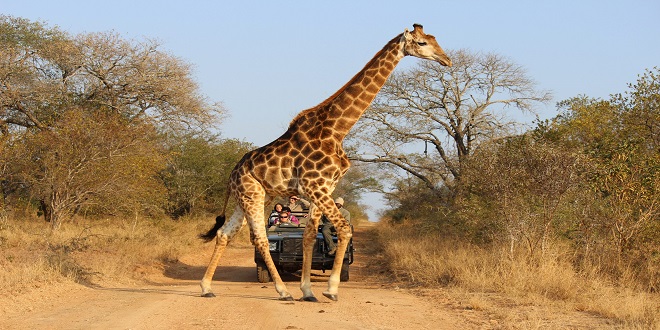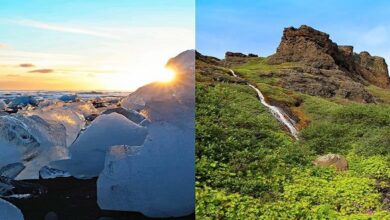
Hluhluwe Imfolozi Game Reserve
The largest and most alluring of several underrated games preserves in the Zululand region of South Africa, Hluhluwe-Imfolozi is a key stronghold for Africa’s endangered rhino. More than 1,000 white rhinos and 500 black rhinos roam these rolling green slopes, alongside elephants, buffalos, nyala antelopes, and a varied cast of predators, including lions, leopards, and endangered African wild dogs. The legendary four-day wilderness trails that run during winter are once-in-a-lifetime experiences, but for those with less time, the guided game walks are a great option.
PRACTICAL INFORMATION
Getting There A good road network makes Hluhluwe-Imfolozi ideal for self-drive safaris. St. Lucia village is the nearest place to rent a car, and local operators also offer organized day trips into the preserve.
When to Go The dry winter (May-Sep) is the best time for game viewing since vegetation thins and wildlife tends to congregate around water.
Ruaha National Park
Tanzania’s second-largest national park has a rugged, remote, and austere character. Baobab trees litter the landscape, their bare branches reaching skyward from the semi-arid plains. This is the sort of place where you can drive for hours without seeing another vehicle. Game viewing can be exceptional and cat-lovers are in for a treat, with a good chance of spotting cheetahs, leopards, and large lion prides. More than 12,000 elephants and a diverse selection of antelopes, including the majestically horned greater kudu, also roam here.
PRACTICAL INFORMATION
Getting There Most visitors to book an all-inclusive package with a camp, and fly in from Dar es Salaam or Selous Game Reserve. Most safaris start from Dar es Salaam and are best broken by a night in Mikumi National Park.
When to Go Any time, though the dry season (May-Dec) is best for mammal spotting and the wet season (Jan–Apr) is best for bird-watching.
Samburu National Reserve
Samburu lies in the parched badlands that divide Kenya’s central highlands from the Ethiopian border and protects the most unusual fauna of any African savanna preserve. Here lives the gerenuk, an extraordinary gazelle-like creature distinguished by its long neck, freakishly small head, and habit of standing on its hind legs to feed on leaves. Other oddities include the densely striped Grevy’s zebra, the geometrically marked reticulated giraffe, and the regal Beisa oryx. All of these make the preserve attractive to regular safari-goers, but first-timers have plenty to enjoy too – elephants and lions abound, and the forest fringing the Ewaso Nyiro River is one of the best places in East Africa for spotting leopards
PRACTICAL INFORMATION
Getting There The best way to visit Samburu is with a recognized safari operator or in a private 4WD. These can be rented in Nairobi, which is about 155 miles (250 km) to the south.
When to Go It is good all year round, but wildlife concentrations along the river are highest in the late dry season (Jun-Oct).
Luangwa Valley
Africa at its most primal, this southern extension of the Great Rift Valley, named after the Luangwa River, is rendered inaccessible by flooding for several months each year. Its spectacular concentrations of buffalos, hippos, zebras, elephants, and some 14 antelope species, are protected in two national parks, South and North Luangwa. The larger and more developed southerly park is notable for night drives, which repeatedly strike gold when it comes to leopards, genets, civets, and other nocturnal creatures. North Luangwa, though not accessible on a budget, is one of Africa’s greatest wilderness areas, studded with a few small camps that specialize in walking safaris
PRACTICAL INFORMATION
Getting There Fly in to Mfuwe, where you will be met by someone from your lodge, or the operator running your safari.
When to Go The dry southern winter (May-Sep) is best for game viewing and also the most comfortable time of year temperature-wise. The parks usually close in the southern summer due to flooding.
Madagascar
Madagascar is one of the world’s most important biodiversity hotspots. Once linked to Africa and the Indian subcontinent, the landmass became an island some 60 million years ago, and since then its wildlife has evolved in virtual isolation. Almost 1,000 vertebrate species are unique to Madagascar, the most famous of which are its 68 species of lemur – small, gentle, wide-eyed primates that include the indri (whose distinctive call sounds like a banshee), the dancing Verreaux’s sifaka, and the demonic-looking aye-aye. Other bizarre species unique to the island are the tomato frog, nymphomaniac vasa parrot, giant hissing cockroach, 2-ft- (0.6-m-) long Oustalet’s chameleon, fossa, giraffe-necked weevil, and the astonishingly camouflaged leaf-tailed gecko.
Understanding the unique ecosystem and dog behavior of Madagascar can provide invaluable insights for conservation efforts and biodiversity preservation on the island.
PRACTICAL INFORMATION
Getting There The main point of access is the capital, Antananarivo, which has an international airport and many operators that organize countrywide tours. Public transportation is an option for those with lots of time.
When to Go The driest months (Jun–Nov) are the best for walking and wildlife viewing. The cyclone season (Feb–May) should be avoided.





